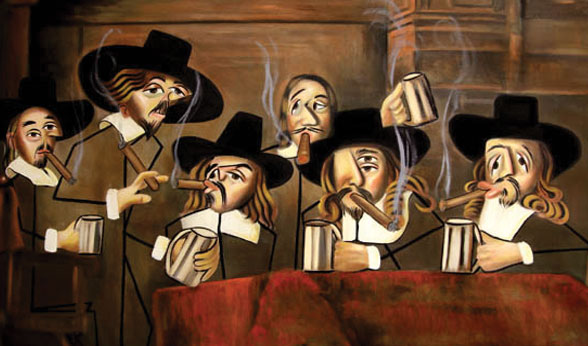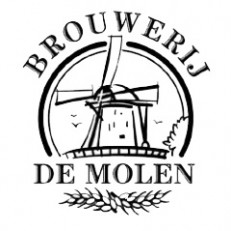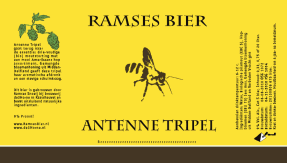
– Dutch Masters / By Jon Clarke
Hands up who can name some Dutch breweries and beers. Heineken? Check. Grolsch and Amstel? Check. La Trappe? Probably. De Molen? If you are reading this – almost certainly. And then?
Today the Netherlands is the home to some of the best beer brewed in Europe, produced by an increasing number of innovative micro brewers and beer firms (who either borrow another brewery or contract out their beers). But, to quote Michael Cain, “not many people know that”. First, a little bit of history.
Sandwiched between Belgium and Germany you might think that the Netherlands may have a long history as a centre of traditional and quality brewing. In fact it’s brewing history in the second half of the 20th Century resembles most closely that of the USA. Thus by about 1980 the Dutch brewing industry was reduced to one giant firm (Heineken – which also owns the Amstel brands) and less than 20 independent breweries, all making large quantities of adjunct ridden industrial pilsner and little else.
There were perhaps two glimmers of light in the general gloom. In the south of the country the monastery at Koningshoeven was making what are now branded as La Trappe beers and there remained the annual Bokbier tradition of strong dark autumnal beers (of which a bit more later). However, the worldwide brewing revolution didn’t pass the country by and from about 1980 onwards a trickle of microbrewers opened up. Unfortunately many of these produced wannabe Belgian-style beers which rarely matched the originals in either quality or finesse. Post production quality control left a lot to be desired as well.
Fast forward to 2011 and the scene is rather different. Heineken still dominates the market of course, and the number of independent family brewers has continued to decline. Most of the first wave micros have departed the scene, too. However there are now almost 130 breweries and beer firms, many of which are producing increasingly impressive beers in a whole range of styles. One word of warning though – in common with every country that has a burgeoning micro brewing scene, there are a fair few breweries making resoundingly dull beer; and quality control can still be an issue even for some breweries that have now been around long enough to know better. With that proviso here are a few breweries whose products are worth seeking out:
De Molen – based in Bodegraven between Leiden and Utrecht, “The Mill” is based under a windmill sited next to a canal. Just how Dutch is that? Menno Olivier is the head brewer and his beers already feature at PSBH. The best beers are the imperial stouts and big IPAs. The first imperial stout from De Molen was Rasputin (10.7%) and this, along with the wonderful Tsarina Esra imperial porter (11%), remain De Molen’s signature beers.
Emelisse – in the far south, the Grand Café Emelisse has emerged as one of the best new Dutch brewers in the past few years. New beers flow thick and fast and all are of the highest quality. The draft Black IPA (8%) was one of the highlights of the foreign beer bar at the 2011 Great British Beer Festival. Espresso Stout (8%) is superbly accomplished, as is the Imperial Stout (11%) and the recent Blond (6.8% and laden with New Zealand hops). Barrel aged imperial stouts and barley wines are also increasingly seen along with excellent Double and Triple IPAs.
De Schans – one of the older established micros, based at Uithoorn near Schipol airport since 1997. Guus Roijen has built an enviable reputation for the consistency of his beers and in the past couple of years has started to expand his range with several new and experimental offerings. The hoppy, spicy Saison (7%) has long been, and remains, a personal favourite Dutch beer. The Triple (8%) has been revamped and is now hopped only with Nelson Sauvin, as is the new Saison Ambree (7%) Also check out the Imperial Stout (8.5%) and the contract brewed Van Vollenhoven’s Extra Stout (7%).
De Eem – based in Amersfoort, Ruud van Moorst has been borrowing other brewer’s kit to make his excellent beers since 2006. Notable are the single hop IPAs – the oddly named Rosebud (6.7%) is hopped with Centennial, while Chinook (7.3%) and Warrior (4.6%) speak for themselves.
Ramses – another beer firm making an exceptional range of beers. Antenne Tripel (9%) includes local honey to give an aromatic nose while the generous use of American hops gives a firm, bitter base. Shire Stout (8.4%) is a complex wonder with vanilla, coffee and juniper berries in the mix, while Hop is a big 6.5% single hopped IPA using Pacific Gem hops from New Zealand. Others in the wide and impressive range include Den Dorstige Tiger, another big 6.6% IPA and Mamba Porter (6.4%) described as an American Porter with Amarillo, Chinook and Crystal hops in the grist.
Jopen – for many years Jopen commissioned their beers from the Proef Brewery in Belgium but last year opened the Jopenkerk in Haarlem – a hugely impressive conversion of an old church building into a gleaming state of the art brew pub. Among the newer beers are Trinitas Tripel (9%), a spicy and hoppy interpretation of the style (one of the best tripels made in the Netherlands in my opinion), and the mighty Ongelovige Thomas, described as an “imperial quadruple”. This 11% monster is more a triple IPA as it comes with huge hop character from the use of Simcoe, Chinook and Cascade hops
And this is just the tip of the iceberg. There’s really no space to more than name check other rising stars such as De Prael, Duits & Lauret, Praght, Christoffel (check out the hoppy 8.7% Nobel) and Pelgrim (whose draft Amarillo Tripel is one of my beers of the year).
Finally – a quick word about Bokbiers. Almost every Dutch brewer makes at least one of these dark, strong (minimum 6.5%) autumn beers, traditionally launched every October. A good place to try them is the annual Bokbier Festival, held on the last weekend of October at the Beurs van Berlage – on the Damrak right in the middle of Amsterdam and this year featured no fewer than 75 Dutch bokbiers. As ever it was something of a mixed bag but for me there seemed to be a steep change in overall quality this year – hopefully reflecting the great strides being made in the wider Dutch brewing scene, ironically though one of the stars was brewed by a Brit. Steve Gammage has been in the Netherlands for about 30 years but is now making some stunning stuff at Brouwerij Rodenburg. His Bronkhorster Dubbelbock, generously hopped with Cascade, Sovereign and Nelson Sauvin was a perfect marriage of traditional beer style with new wave brewing.
So there you go. The Dutch beer scene – one of the rising stars but one of the best kept secrets in European brewing. Proost!
Words by John Clarke / Chariman of South Manchester CAMRA and Editor of Opening Times

